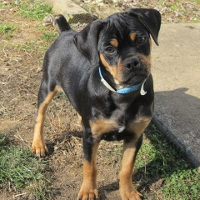Appearance of the Muggin
|
| The Muggin's appearance will depend on the characteristics it inherits from its parent breeds. It may inherit the short muzzle and curly tail of the Pug, or the longer or shorter muzzle of the Miniature Pinscher. The Pug will have small, thin ears, while the Miniature Pinscher's ears are set high on its head. The Muggin can be seen in many colors, including cream, black, brown, gold and white. Muggins can also have a combination of colors such as black and tan. The Muggin's coat is generally short and fine, and hybrid dogs often shed. |
Temperament of the Muggin
|
| The Muggin will be affectionate and gentle towards its human, taking the opportunity to curl up next to you while you read or watch TV. Part of its affection will include lots of licking of its favorite humans. The hybrid may bark a few times when it hears a strange noise or meets a new person, but once determined it fears no danger, it will relax and its gentle nature will show. Separation anxiety occurs in the Muggin, who will be nervous that you won't come back when you leave. Having another dog to spend time with will help alleviate this for him. The Muggin will do well with children, although if handled roughly, it could nip. |
Needs and activities of the Muggin
|
| While the Pug is rather inactive, the Muggin often follows in the footsteps of its Miniature Pinscher parent, having a higher activity and energy level. Your Muggin will probably be delighted to go for regular walks once or twice a day with the children, as its hobbies are both indoors and outdoors. If you notice that your Muggin is acting out, it may be a sign that he needs more physical activity and stimulation, both mental and physical, to get his energy out and avoid boredom. Muggins tend to be overweight, and exercise will be important to help them maintain a healthy weight. The hybrid will do very well in an apartment if taken outside for walks and hobbies. |
Maintenance of the Muggin
|
| Muggins shed regularly and more heavily in spring and winter. Daily brushing of your Muggin will be necessary, as well as regular cleaning of your floors and furniture. The Muggin's short coat is easy to brush with a stiff bristle brush. The hybrid should only be bathed when necessary, as washing your Muggin too often can lead to dry skin problems. To remove discarded fur, you can wipe your dog with a damp cloth. As with all dogs, his teeth should be brushed at least twice a week to ensure long-term dental health. Your Muggin's nails should be trimmed as needed, and his ears checked weekly for infection. |









 English (United Kingdom)
English (United Kingdom)